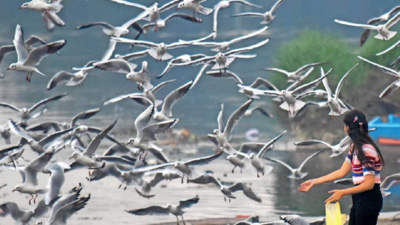- News
- City News
- gurgaon News
- Haryana's Sultanpur bird park opens to visitors today
Trending
This story is from November 1, 2021
Haryana's Sultanpur bird park opens to visitors today
The gates of Sultanpur National Park will be thrown open for visitors today for the first time in over 19 months. The park was closed on March 18 last year, a week before the nationwide lockdown due to Covid-19, and has remained closed since then.

<p>Only 20 people or less will be allowed on the premises within three hours, said a wildlife official. (File photo)<br></p>
GURUGRAM: The gates of Sultanpur National Park will be thrown open for visitors today for the first time in over 19 months. The park was closed on March 18 last year, a week before the nationwide lockdown due to Covid-19, and has remained closed since then.
Visitors will be allowed in the park from 7.30am to 4.30pm and have to adhere to Covid-appropriate behaviour inside the park. Sultanpur National Park was designated a Ramsar site, a wetland of international significance, in May this year.
The administration has come up with new rules to prevent crowding inside and outside the park. Only 20 people or less will be allowed on the premises within three hours, said a wildlife official. Meanwhile, only those with no symptoms of Covid and wearing masks will be allowed entry into the park after they mark themselves safe on the Aarogya Setu app.
ML Mallik, the wildlife conservator, south Haryana, said, “The park will be open from tomorrow (November 1) for the public. The migratory birds have started to visit the park, so it's the ideal time for the park to reopen.” The park will be closed on Tuesdays. In pre-Covid times, the park used to remain closed from June 1 to September 30 and reopened on October 1, registering a footfall of 8,000-10,000 during the weekends.
In winter, a large number of birds fly millions of miles to reach the wetlands for resting and feeding, said a park staff. The migratory birds that frequent the park can be broadly categorised as waders, birds dependent on shallow water; singing warblers and ducks.
The Sultanpur wetland supports over 220 species of resident, winter migratory and local migratory waterbirds at critical stages of their life cycles, said a birder. Over ten of such migratory birds are globally threatened. This includes the critically endangered sociable lapwing.
Birders welcomed the decision to reopen the site but advised caution. “Surveillance of people who enter the park is important as birds should not get disturbed because of human interference,” said Pankaj Gupta, a birder with the Delhi Bird Society.
In June this year, the circular area around Sultanpur National Park, starting from the park boundary and reaching up to five kilometres, was declared as an eco-sensitive zone by the state forest and wildlife department. The zonal master plan for this area was notified on June 18 and under the plan, no construction will be allowed within 300 metres of the park.
Visitors will be allowed in the park from 7.30am to 4.30pm and have to adhere to Covid-appropriate behaviour inside the park. Sultanpur National Park was designated a Ramsar site, a wetland of international significance, in May this year.
The administration has come up with new rules to prevent crowding inside and outside the park. Only 20 people or less will be allowed on the premises within three hours, said a wildlife official. Meanwhile, only those with no symptoms of Covid and wearing masks will be allowed entry into the park after they mark themselves safe on the Aarogya Setu app.
ML Mallik, the wildlife conservator, south Haryana, said, “The park will be open from tomorrow (November 1) for the public. The migratory birds have started to visit the park, so it's the ideal time for the park to reopen.” The park will be closed on Tuesdays. In pre-Covid times, the park used to remain closed from June 1 to September 30 and reopened on October 1, registering a footfall of 8,000-10,000 during the weekends.
One of Gurugram’s most popular tourist spots, the park has nearly 6,000 birds, including at least 30 species of water birds, according to the wildlife department. Park visitors may come across the common coot, northern pintail, tufted pochard, common pochard, northern shoveller, gadwall, glossy ibis, demoiselle crane, darter, painted stork, cormorant, black-necked stork, sarus crane, openbill stork, woolly-necked stork, spoonbill, crested serpent eagle, booted eagle, short-eared owl, brown hawk-owl, cattle egret, heron, swamphen, Sind sparrow, among others.
In winter, a large number of birds fly millions of miles to reach the wetlands for resting and feeding, said a park staff. The migratory birds that frequent the park can be broadly categorised as waders, birds dependent on shallow water; singing warblers and ducks.
The Sultanpur wetland supports over 220 species of resident, winter migratory and local migratory waterbirds at critical stages of their life cycles, said a birder. Over ten of such migratory birds are globally threatened. This includes the critically endangered sociable lapwing.
Birders welcomed the decision to reopen the site but advised caution. “Surveillance of people who enter the park is important as birds should not get disturbed because of human interference,” said Pankaj Gupta, a birder with the Delhi Bird Society.
In June this year, the circular area around Sultanpur National Park, starting from the park boundary and reaching up to five kilometres, was declared as an eco-sensitive zone by the state forest and wildlife department. The zonal master plan for this area was notified on June 18 and under the plan, no construction will be allowed within 300 metres of the park.
End of Article
FOLLOW US ON SOCIAL MEDIA










